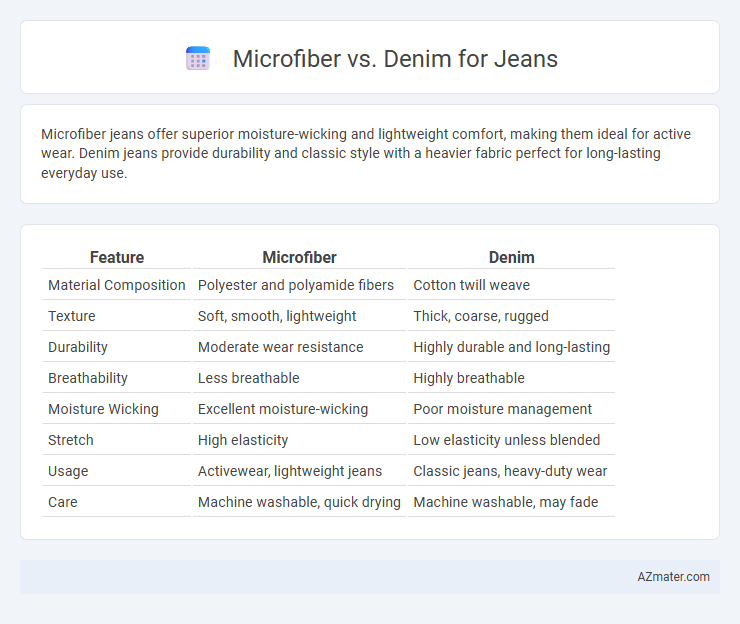Microfiber jeans offer superior moisture-wicking and lightweight comfort, making them ideal for active wear. Denim jeans provide durability and classic style with a heavier fabric perfect for long-lasting everyday use.
Table of Comparison
| Feature | Microfiber | Denim |
|---|---|---|
| Material Composition | Polyester and polyamide fibers | Cotton twill weave |
| Texture | Soft, smooth, lightweight | Thick, coarse, rugged |
| Durability | Moderate wear resistance | Highly durable and long-lasting |
| Breathability | Less breathable | Highly breathable |
| Moisture Wicking | Excellent moisture-wicking | Poor moisture management |
| Stretch | High elasticity | Low elasticity unless blended |
| Usage | Activewear, lightweight jeans | Classic jeans, heavy-duty wear |
| Care | Machine washable, quick drying | Machine washable, may fade |
Introduction to Microfiber and Denim Fabrics
Microfiber fabrics are composed of ultra-fine synthetic fibers that offer exceptional softness, breathability, and moisture-wicking properties, making them a popular choice for innovative, lightweight jeans. Denim, traditionally woven from coarse cotton fibers, is renowned for its durability, rugged texture, and classic blue-indigo dye, which provides a timeless aesthetic and long-lasting wear. Understanding the fiber composition and weaving techniques highlights the contrasting characteristics of microfiber's smooth flexibility and denim's sturdy robustness in jeans production.
Historical Background of Denim and Microfiber
Denim originated in the late 19th century as durable workwear fabric primarily made from cotton twill, gaining popularity during the California Gold Rush and becoming synonymous with rugged American style. Microfiber, a synthetic fabric developed in the 1950s from ultra-fine polyester and polyamide fibers, offers lightweight durability and moisture-wicking properties, vastly different from traditional denim's cotton composition. Over time, microfiber has been integrated into jeans to enhance comfort and flexibility while maintaining the classic appearance of denim.
Material Composition: Microfiber vs Denim
Microfiber jeans are crafted from synthetic fibers like polyester and nylon, offering lightweight durability, moisture-wicking properties, and enhanced stretch compared to traditional denim. Denim is made from 100% cotton or cotton blend twill fabric, known for its strength, breathability, and classic texture that softens with wear. The contrast in material composition gives microfiber jeans superior flexibility and quick drying, while denim ensures timeless ruggedness and long-lasting comfort.
Comfort and Wearability Comparison
Microfiber jeans provide superior comfort due to their lightweight, breathable, and flexible fabric that adapts well to body movements, reducing chafing and enhancing wearability during extended use. Denim, known for its durability and classic look, tends to be heavier and less flexible, which can lead to stiffness and reduced comfort, especially when new or untreated. Choosing microfiber over denim results in increased softness and moisture-wicking properties, making it ideal for active lifestyles and all-day wear.
Durability and Longevity in Daily Use
Microfiber jeans offer superior resistance to wear, moisture, and stains, enhancing their durability for daily use compared to traditional denim. Denim, known for its robust cotton twill weave, provides long-lasting strength but tends to fade and weaken after frequent washing and heavy wear. Choosing microfiber jeans results in extended longevity with less maintenance, while denim excels in developing a unique character and durability through consistent use.
Style and Fashion Trends: Microfiber vs Denim Jeans
Microfiber jeans offer a sleek, modern look with a smooth texture that appeals to contemporary fashion enthusiasts seeking comfort and versatility. Denim remains a timeless classic in style, celebrated for its rugged durability and iconic appeal across diverse fashion trends from casual to high-end streetwear. Current style trends highlight microfiber's growing popularity for its lightweight feel, while denim continues dominating mainstream fashion due to its enduring authenticity and adaptability.
Maintenance and Care Requirements
Microfiber jeans require low-maintenance care, as their synthetic fibers resist stains and dry quickly, eliminating the need for frequent washing. Denim jeans demand more rigorous care, including cold washes and air drying to preserve their cotton fibers and prevent fading or shrinking. Proper care for each fabric ensures longevity, with microfiber offering convenience and denim necessitating traditional, attentive maintenance.
Environmental Impact and Sustainability
Microfiber jeans offer a significant reduction in water usage and chemical treatments compared to traditional denim production, contributing to lower environmental impact. Denim, typically made from cotton, demands intensive water consumption and pesticide use, raising sustainability concerns. Sustainable alternatives in denim manufacturing, such as organic cotton and recycled fibers, aim to mitigate these effects but still generally have a higher ecological footprint than microfiber fabrics.
Price Differences and Value for Money
Microfiber jeans typically cost less than denim jeans due to lower production expenses and faster manufacturing processes, offering an affordable option for fashion-conscious consumers. Denim jeans, known for durability and classic style, often come at a higher price point but provide long-term value through extended wear and resistance to fading and tearing. Evaluating price differences and material quality helps shoppers balance initial cost versus longevity and overall value for money.
Choosing the Right Fabric: Microfiber or Denim?
Choosing between microfiber and denim for jeans depends on desired comfort, durability, and style. Microfiber offers lightweight softness, moisture-wicking properties, and flexibility, ideal for active wear or warm climates, while denim provides classic strength, rugged texture, and long-lasting resilience suitable for casual and heavy-duty use. Prioritize microfiber for breathable, stretchable jeans and denim for traditional, sturdy fashion statements.

Infographic: Microfiber vs Denim for Jeans
 azmater.com
azmater.com